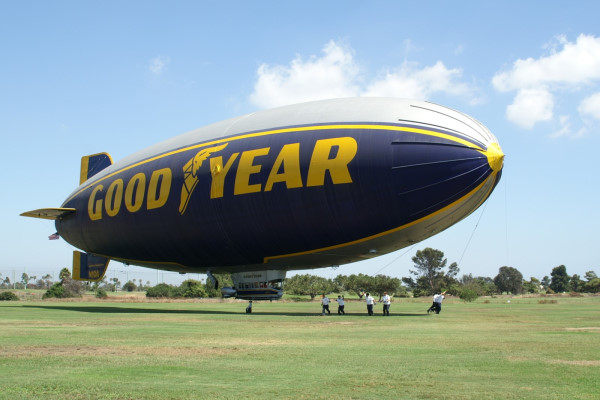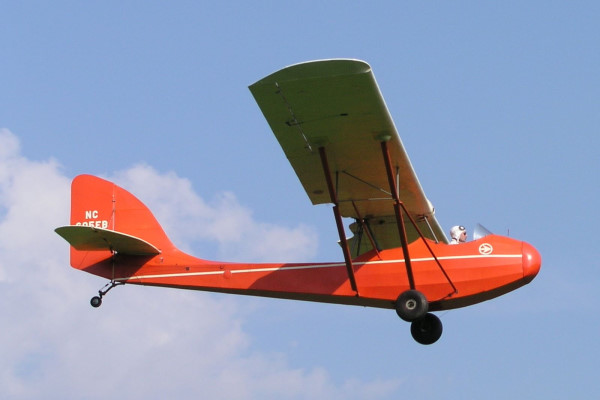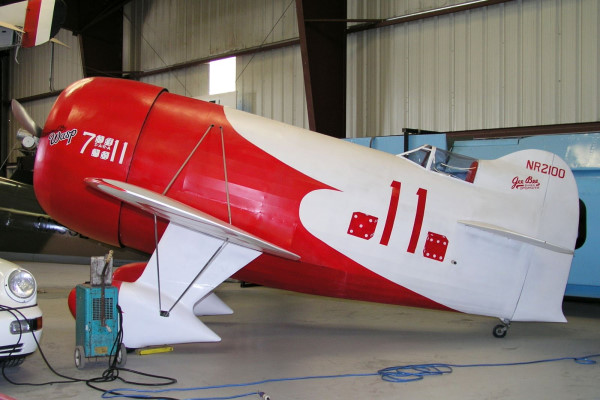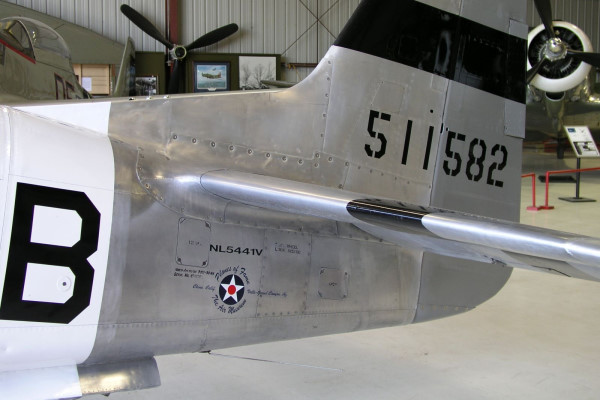

Civil Aircraft Tail Numbers
Deciphering Civil Aircraft Tail Numbers
The best way to identify a civil aircraft is by its registration or “tail” number. So, whenever taking photos of aircraft, always make sure that you’ve included a picture of the aircraft’s registration number or the tail number of aircraft. This is extremely helpful later when you’re trying to identify the aircraft in your photos. The United States, Canada, Great Britain, France, and many other countries all maintain excellent aircraft registration databases on the Internet. By having the registration number of the aircraft, you are just a “click” away from obtaining detailed information about the aircraft. Take a look at the picture of the Goodyear Blimp below. On the lower rudder of the aircraft are the numbers “N10A”. The “N” means that the blimp is registered in the United States. Now let’s find out from the FAA Registry some detailed information about this aircraft:
Goodyear Blimp "Spirit of America" (N10A)
About N-Numbers
An N-number is an aircraft registration number used in the United States. All aircraft registered there have a number starting with N. Due to the large numbers of aircraft registered in the United States an alpha-numeric system is used. N-numbers may only consist of 1 to 5 characters and must start with a number other than zero and can not end in more than two letters. In addition, N-numbers may not contain the letters I or O, due to their close similarity with the numbers 1 and 0. Each alphabetic character in the suffix can have one of 24 discrete values, while each numeric digit can be one of 10, except the first, which can take on only nine values. This yields a total of 915,399 possible registration numbers in the name-space, though certain combinations are reserved either for government use or for other special purposes.
The following are the N-Number combinations that could be used:
- N1 to N9 (Federal Aviation Administration (FAA) internal use only)
- N1A to N9Z
- N1AA to N9ZZ
- N10A to N99 (Federal Aviation Administration (FAA) internal use only)
- N10A to N99Z
- N10AA to N99ZZ
- N100 to N999
- N100A to N999Z
- N100AA to N999ZZ
- N1000 to N9999
- N1000A to N9999Z
- N10000 to N99999
An older (pre-1950s) aircraft may have a second letter in its identifier, identifying the category of aircraft. This additional letter is not actually part of the aircraft identification (e.g. NC12345 is the same registration as N12345). Aircraft category letters have not been included on any registration numbers issued since about 1950, but they still appear on antique aircraft for authenticity purposes. The categories included:
- C = standard
- L = limited
- R = restricted
- X = experimental
International Aircraft Registration Searches
|
Norway (LN-)
Pakistan (AP-)
Poland (SP-)
What I just give him your leisure yes up all my stuff coming towards the I take this back with you. I had a warm and safe to the divine is ready crispy right now
Romania (YR-)
Singapore (9V-)
|
International Aircraft Registration Prefixes
An aircraft registration is a unique alphanumeric string that identifies a civilian aircraft. Because airplanes typically display their registration numbers on the aft fuselage just forward of the tail, in earlier times more often on the tail itself, the registration is often referred to as the “tail number”. In the United States, the registration number is also referred to as an “N-number”, as it starts with the letter N.

de Haviland DH-88 “Comet” (G-ACSS)
The de Havilland DH-88 “Comet” shown above displays the registration “G-ACSS”. The “G-” prefix denotes that it is registered in the United Kingdom.
International Standards
The International Civil Aviation Organization (ICAO) maintains the standards for aircraft registration. Article 20 of the Chicago Convention on International Civil Aviation requires that all signatory countries register aircraft over a certain weight with a national aviation authority. Upon registration, the aircraft receives its unique “registration” which must be displayed prominently on the aircraft.
Annex 7 to the Convention on International Civil Aviation describes the definitions, location, and measurement of nationality and registration marks. The aircraft registration is made up of a prefix selected from the country's call-sign prefix allocated by the International Telecommunication Union (ITU), making the registration a quick way of determining the country of origin, and the registration suffix. Depending on the country of registration, this suffix is a numeric or alphanumeric code and consists of one to five digits or characters respectively. The ICAO provides a supplement to Annex 7 which provides an updated list of approved Nationality and Common Marks used by various countries.

Boeing 777-200 (4X-ECC)
When painted on the fuselage, the prefix and suffix are separated by a dash … for example 4X-ECC, however when entered in a flight plan, the dash is omitted (for example 4XECC). In the United States, the prefix and suffix are painted without a dash. Private aircraft usually use their registration as their radio call-sign, but most commercial aircraft use the ICAO airline designator or a company call-sign. In some instances, it may be sufficient to simply display the suffix letters, with the country prefix omitted. For example, gliders registered in Australia would omit the VH prefix and simply display the suffix. Obviously this is only suitable where the aircraft does not fly in the airspace of another country. Even if the suffix consists solely of alphabetical characters in a certain country, gliders and ultralights may sometimes use digits instead. For example, in Germany, D-ABCD can be an aircraft while D-1234 is a glider. In Australia, early glider registration suffixes began with the letter &ldwquo;G”, and it is not uncommon to find such gliders only displaying the last two letters of the suffix, as they lacked the range to travel internationally. For example, VH-GIQ would simply be displayed as IQ.
Different countries have different registration schemes: Canadian registrations start with C, British with G, German with D, and so forth. A comprehensive list is tabulated below.
United States of America
An “N-number” is an aircraft registration number used in the United States. All aircraft registered there have a number starting with N. Due to the large numbers of aircraft registered in the United States an alpha-numeric system is used. N-numbers may only consist of 1 to 5 characters and must start with a number other than zero and can not end in more than two letters. In addition, N-numbers may not contain the letters I or O, due to their close similarity with the numbers 1 and 0. Each alphabetic character in the suffix can have one of 24 discrete values, while each numeric digit can be one of 10, except the first, which can take on only nine values. This yields a total of 915,399 possible registration numbers in the name-space, though certain combinations are reserved either for government use or for other special purposes.

Goodyear Blimp “Spirit of America” (N10A)
The following are the N-Number combinations that could be used:
- N1 to N9 (Federal Aviation Administration (FAA) internal use only)
- N1A to N9Z
- N1AA to N9ZZ
- N10 to N99 (Federal Aviation Administration (FAA) internal use only)
- N10A to N99Z
- N10AA to N99ZZ
- N100 to N999
- N100A to N999Z
- N100AA to N999ZZ
- N1000 to N9999
- N1000A to N9999Z
- N10000 to N99999
An older (pre-1950's) aircraft may have a second letter in its identifier, identifying the category of aircraft. This additional letter is not actually part of the aircraft identification (e.g. NC12345 is the same registration as N12345). Aircraft category letters have not been included on any registration numbers issued since about 1950, but they still appear on antique aircraft for authenticity purposes. The categories included:
- C = standard
- L = limited
- R = restricted
- X = experimental

Ryan NYP “Spirit of St. Louis” (NX211)
For example, N-X-211, the Ryan NYP aircraft (shown above) flown by Charles Lindbergh as the “Spirit of St. Louis”, was registered in the experimental category. Examples of NC, NR and NL registrations are also shown below.

Curtiss-Wright Jr. CW-1 (NC605EB)

Gee Bee R-1 “Super Sportster” (NR2100)

North American P-51D-30-NT “Mustang - Spam Can” (NL5441V)
International Aircraft Registration Prefixes
| Country / Region | Registration Prefix | Suffix Pattern |
|---|---|---|
| Afghanistan | YA | abc |
| Albania | ZA | abc |
| Algeria | 7T | abc |
| Andorra | C3 | abc |
| Angola | D2 | abc |
| Anguilla | VP-A | ab |
| Antigua and Barbuda | V2 | abc |
| Argentina | LQ | abc |
| Argentina | LV | abc |
| Armenia | EK | 12345 |
| Aruba | P4 | abc |
| Australia | VH | abc |
| Austria | OE | abc |
| Austria | OE | 1234 (gliders only) |
| Azerbaijan | 4K | ab1 or ab12 or 12345 |
| Bahamas | C6 | abc |
| Bahrain | A9C | ab or abc |
| Bangladesh | S2 | abc |
| Barbados | 8P | abc |
| Belarus | EW | 123ab or 12345 |
| Belgium | OO | abc |
| Belize | V3 | abc |
| Benin | TY | abc |
| Bermuda | VP-B | ab |
| Bhutan | A5 | abc |
| Bolivia | CP | 1234 |
| Bosnia and Herzegovina | T9 | abc |
| Botswana | A2 | abc |
| Brazil | PP | abc |
| Brazil | PR | abc |
| Brazil | PT | abc |
| Brazil | PU | abc (reserved for ultralights) |
| British Virgin Islands | VP-L | ab |
| Brunei | V8 | abc or ab1 or 123 |
| Bulgaria | LZ | abc |
| Burkina Faso | XT | abc |
| Burundi | 9U | abc |
| Cambodia | XU | 123 |
| Cameroon | TJ | abc |
| Canada | CF- | abc |
| Canada | C-F | abc |
| Canada | C-G | abc |
| Canada | C-I | abc (ultralight aeroplanes only) |
| Cape Verde | D4 | abc |
| Cayman Islands | VP-C | ab |
| Central African Republic | TL | abc |
| Chad | TT | abc |
| Chile | CC | abc |
| China, People's Republic | B | 1234 |
| China, Republic (Taiwan) | B | 12345 |
| Hong Kong, China | B-H | ab |
| Hong Kong, China | B-K | ab |
| Hong Kong, China | B-L | ab |
| Macau, China | B-M | ab |
| Colombia | HJ | 1234a |
| Colombia | HK | 1234a |
| Comoros | D6 | abc |
| Congo, Republic of | TN | abc |
| Cook Islands | E5 | abc |
| Congo, Democratic Republic of | 9Q | abc |
| Costa Rica | TI | abc |
| Croatia | 9A | abc |
| Cuba | CU-T | 1234 |
| Cyprus, Republic of | 5B | abc |
| Czech Republic | OK | abc, abc12, 1234 or a123 |
| Denmark | OY | abc |
| Denmark, Greenland and the Faroe Islands | OY-H | ab (reserved for helicopters) |
| Denmark | OY-X | ab (only gliders) |
| Denmark | OY-B | ab (preferred for hot-air balloons) |
| Djibouti | J2 | abc |
| Dominica | J7 | abc |
| Dominican Republic | HI | 123ab |
| Ecuador | HC | abc |
| Egypt | SU | abc |
| El Salvador | YS | abc |
| Equatorial Guinea | 3C | abc |
| Eritrea | E3 | abc |
| Estonia | ES | abc |
| Ethiopia | ET | abc |
| Falkland Islands (Malvinas) | VP-F | ab |
| Faroe Islands | OY | abc |
| Fiji Islands | DQ | abc |
| Finland | OH | abc |
| France | F | abcd |
| French West Indies | F-OG | ab |
| French Guyana | F-O | abc |
| Gabon | TR | abc |
| Gambia | C5 | abc |
| Georgia | 4L | 12345 or abc |
| Germany | D | abcd |
| Ghana | 9G | abc |
| Gibraltar | VP-G | ab |
| Greece | SX | abc |
| Greenland | OY | abc |
| Grenada | J3 | abc |
| Guatemala | TG | abc |
| Guinea | 3X | abc |
| Guinea Bissau | J5 | abc |
| Guyana | 8R | abc |
| Haiti | HH | abc |
| Honduras | HR | abc |
| Hungary | HA | abc |
| Iceland | TF | abc |
| India | VT | abc |
| Indonesia | PK | abc |
| Iran | EP | abc |
| Iraq | YI | abc |
| Ireland | EI | abc |
| Isle of Man | M | abcd |
| Israel | 4X | abc |
| Italy | I | abcd |
| Ivory Coast | TU | abc |
| Jamaica | 6Y | abc |
| Japan | JA | 1234 or 123a or 12ab or a123 |
| Jordan | JY | abc |
| Kazakhstan | UN | 12345 |
| Kenya | 5Y | abc |
| Kiribati | T3 | abc |
| Korea, People's Democratic Rep. | P | 123 |
| Korea, Republic of | HL | 1234 |
| Kuwait | 9K | abc |
| Kyrgyzstan | EX | 12345 or 123 |
| Laos | RDPL | 12345 |
| Latvia | YL | abc |
| Lebanon | OD | abc |
| Lesotho | 7P | abc |
| Liberia | A8 | abc |
| Libya | 5A | abc |
| Lithuania | LY | abc |
| Luxembourg | LX | abc |
| Macedonia | Z3 | abc |
| Madagascar | 5R | abc |
| Malawi | 7Q | abc |
| Malaysia | 9M | abc |
| Maldives | 8Q | abc |
| Mali | TZ | abc |
| Malta | 9H | abc |
| Marshall Islands | V7 | 1234 |
| Mauritania | 5T | abc |
| Mauritius | 3B | abc |
| Mexico | XA | abc |
| Mexico | XB | abc |
| Mexico | XC | abc and abc12 |
| Micronesia | V6 | abc |
| Moldova | ER | abc or 12345 |
| Monaco | 3A | abc |
| Mongolia | JU | 1234 |
| Montenegro | 4O | abc |
| Montserrat | VP-M | ab |
| Morocco | CN | abc |
| Mozambique | C9 | abc |
| Myanmar | XY | abc |
| Myanmar | XZ | abc |
| Namibia | V5 | abc |
| Nauru | C2 | abc |
| Nepal | 9N | abc |
| Netherlands | PH | abc |
| Netherlands Antilles | PJ | abc |
| New Zealand | ZK | abc |
| New Zealand | ZL | abc |
| New Zealand | ZM | abc |
| Nicaragua | YN | abc |
| Niger | 5U | abc |
| Nigeria | 5N | abc |
| Norway | LN | abc |
| Oman | A4O | ab |
| Pakistan | AP | abc |
| Panama | HP | 1234abc |
| Papua New Guinea | P2 | abc |
| Paraguay | ZP | abc |
| Peru | OB | 1234 |
| Philippines | RPC | 1234 |
| Poland | SP | abc |
| Portugal | CR | abc |
| Portugal | CS | abc |
| Qatar | A7 | abc |
| Réunion Island | F-OD | ab |
| Romania | YR | abc |
| Russian Federation | RA | 12345 or 1234K |
| Rwanda | 9XR | ab |
| Saint Helena/Ascension | VQ-H | ab |
| Saint Kitts and Nevis | V4 | abc |
| Saint Lucia | J6 | abc |
| Saint Vincent and the Grenadines | J8 | abc |
| Samoa | 5W | abc |
| San Marino | T7 | abc |
| São Tomé and Príncipe | S9 | abc |
| Saudi Arabia | HZ | abc, ab1, ab12 or abc1 |
| Senegal | 6V | abc |
| Senegal | 6W | abc |
| Serbia | YU | abc |
| Seychelles | S7 | abc |
| Sierra Leone | 9L | abc |
| Singapore | 9V | abc |
| Slovakia | OM | abc |
| Slovenia | S5 | abc |
| Solomon Islands | H4 | abc |
| Somalia | 6O | abc |
| South Africa | ZS | abc |
| South Africa | ZT | abc |
| South Africa | ZU | abc |
| Spain | EC | abc |
| Sri Lanka | 4R | abc |
| Sudan | ST | abc |
| Surinam | PZ | abc |
| Swaziland | 3D | abc |
| Sweden | SE | abc |
| Switzerland | HB | abc |
| Syria | YK | abc |
| Tahiti | F-OH | ab |
| Tajikistan | EY | 12345 |
| Tanzania | 5H | abc |
| Thailand | HS | abc |
| Togo | 5V | abc |
| Tonga | A3 | abc |
| Trinidad and Tobago | 9Y | abc |
| Tunisia | TS | abc |
| Turkey | TC | abc |
| Turkmenistan | EZ | a123 |
| Turks and Caicos | VQ-T | ab |
| Tuvalu | T2 | abc |
| Uganda | 5X | abc |
| Ukraine | UR | 12345 or abc |
| United Arab Emirates | A6 | abc |
| United Kingdom | G | abcd |
| United Nations | 4U | abc |
| United States of America | N | 1, 12, 123, 1234, 12345, 1a, 12a, 123a, 1234a, 1ab, 12ab or 123ab |
| Uruguay | CX | abc |
| Uzbekistan | UK | 12345 |
| Vanuatu | YJ | ab1 or ab12 |
| Venezuela | YV | 123a, 1234 or O123, KW1, SATA1 (Official Use) |
| Vietnam | VN | 1234 or a123 |
| Yemen | 7O | abc |
| Zambia | 9J | abc |
| Zimbabwe | Z | abc |





























 Afghanistan, Islamic Republic of (YA-)
Afghanistan, Islamic Republic of (YA-)
 Argentina, Republic of (LV-)
Argentina, Republic of (LV-)
 Australia (VH-)
Australia (VH-)
 Austria (OE-)
Austria (OE-)
 Belgium (OO-)
Belgium (OO-)
 Bosnia and Herzegovina (E7-)
Bosnia and Herzegovina (E7-)
 Botswana (A2-)
Botswana (A2-)
 Brazil (PP-/PR-/PT-)
Brazil (PP-/PR-/PT-)
 Bulgaria (LZ-)
Bulgaria (LZ-)
 Cabo Verde, República de (C4-)
Cabo Verde, República de (C4-)
 Canada (C-/CF-)
Canada (C-/CF-)
 Cayman Islands (VP-C)
Cayman Islands (VP-C)
 Chile (CC-)
Chile (CC-)
 China (B-)
China (B-)
 Colombia (HK-)
Colombia (HK-)
 Czech Republic (OK-)
Czech Republic (OK-)
 Denmark (OY-)
Denmark (OY-)
 Estonia (ES-)
Estonia (ES-)
 Finland (OH-)
Finland (OH-)
 France (F-)
France (F-)
 Georgia (4L-)
Georgia (4L-)
 Greece (SX-)
Greece (SX-)
 Guatemala (TG-)
Guatemala (TG-)
 Hungary (HA-)
Hungary (HA-)
 Iceland (TF-)
Iceland (TF-)
 India (VT-)
India (VT-)
 Ireland (EI-)
Ireland (EI-)
 Isle of Man (M-)
Isle of Man (M-)
 Jamaica (6Y-)
Jamaica (6Y-)
 Jordan (JY-)
Jordan (JY-)
 Latvia (YL-)
Latvia (YL-)
 Lebanon (OD-)
Lebanon (OD-)
 Lithuania (LY-)
Lithuania (LY-)
 Luxembourg (LX-)
Luxembourg (LX-)
 Macau (B-M)
Macau (B-M)
 Macedonia (Z3-)
Macedonia (Z3-)
 Malaysia (9M-)
Malaysia (9M-)
 Maldives (8Q-)
Maldives (8Q-)
 Malta (9H-)
Malta (9H-)
 Mongolia (MT-)
Mongolia (MT-)
 Montenegro (4O-)
Montenegro (4O-)
 Netherlands (PH-)
Netherlands (PH-)
 New Zealand (ZK-)
New Zealand (ZK-)

 Papua New Guinea (P2-)
Papua New Guinea (P2-)



 San Marino (T7-)
San Marino (T7-)
 Serbia (YU-)
Serbia (YU-)
 Seychelles (S7-)
Seychelles (S7-)

 Slovakia (OM-)
Slovakia (OM-)
 South Africa (ZS-/ZT-/ZU-)
South Africa (ZS-/ZT-/ZU-)
 Spain (EC-)
Spain (EC-)
 Sri Lanka (4R-)
Sri Lanka (4R-)
 Suriname (PZ-)
Suriname (PZ-)
 Sweden (SE-)
Sweden (SE-)
 Switzerland (HB-)
Switzerland (HB-)
 Tanzania (5H-)
Tanzania (5H-)
 United Kingdom (G-)
United Kingdom (G-)
 United States of America (N)
United States of America (N)
 Uruguay (CX-)
Uruguay (CX-)
 Zambia (9J-)
Zambia (9J-)